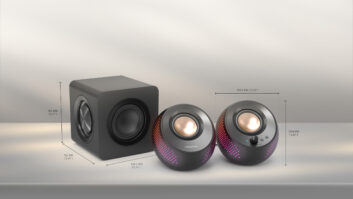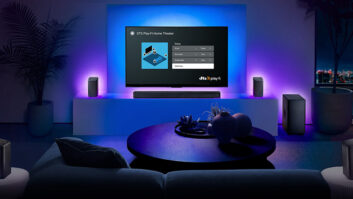Upper Saddle River, N.J. – Onkyo
plans June availability of the world’s first commercially available AV receiver
with DTS Neo:X post-processing technology, which was
at January’s CES.
Neo:X is promoted as the first post-processing
technology to upmix stereo and multi-channel audio programs to as many as 11.1
channels. DTS Neo:X is capable of adding a pair of front-height speakers and a
pair of front-wide speakers to traditional 5.1- and 7.1-channel surround-sound
speaker systems.
The technology appears in the
$1,399-suggested Onkyo TX-NR1009, a THX Select2 Plus Certified 9.2-channel
receiver, which is network-capable.
Using the receiver’s embedded
amplifiers, consumers can use DTS Neo:X to create an of three types of 9.1-channel
home theater systems, the company said. To a basic 5.1-channel speaker system,
users can add surround-back and front-height speakers to produce ambient,
non-directional sounds. Users could alternately opt to add surround back- and
front-wide speakers to a 5.1 system, or they could add front-height and
front-width speakers to a 5.1 system without adding surround-back speakers.
Like the $1,099-suggested
TX-NR809 7.2-channel networked AV receiver announced in recent weeks, the
TX-NR1009 features ISF calibration to optimize the video performance of
connected displays and Marvell’s Qdeo and IDT’s HQV Vida video-processing
technologies. Qdeo, which enables Onkyo to implement ISF calibration, upscales
1080p sources to full 4K (3840 x 2160) resolution. For its part, Vida upscales
480i/p, 576p, and 720p video sources to 1080p, eliminates compressed-video
noise, and features multi-cadence tracking, 12-bit color processing, and
four-field motion-adaptive de-interlacing to improve the quality of standard-
and high-definition video, the company said.
With the launch of the TX-NR1009,
Onkyo is expanding the number of TX series receivers with Qdeo and 4K upscaling
to four with prices starting at $599. Two HT series AVRs also feature Qdeo and 4K
upscaling starting at $549.
Other features common to both AV
receivers include Windows 7 and DLNA networking certification and front and
rear USB inputs, with the front USB input accepting music in digital PCM form
from a connected iPod or iPhone. The inputs also connect to other digital
storage devices and to an optional Onkyo USB LAN adapter. A proprietary Universal Port on both models
accepts an optional HD Radio tuner or an iPod/iPhone dock that streams stored
audio and video from the Apple devices.
Both models also connect to
Internet radio stations through vTuner and to streaming music services
Mediafly, Pandora, Slacker, Napster, Rhapsody, Sirius XM Internet Radio, and
Last.fm.
Other features common to both
include Audyssey MultEQ XT room-correction technology, which corrects for
frequency-response and time-domain errors at several hundred points across the
frequency spectrum; Audyssey DSX post-processing to add front-height or
front-width channels to a 5.1 system to create 9.1-channel surround; Dolby
ProLogic IIz to add front-height channels to a 5.1 or 7.1 system; and Dolby Volume
processing technology to maintain a consistent volume level when connected
audio and video sources are switched, when TV channels are changed, when a TV
program transitions to a commercial and from louder to softer scenes, and when
a broadcast source is switched from analog to digital.
The TX-NR1009 also features one
front- and seven rear-panel HDMI inputs, dual HDMI outputs, Dolby TrueHD and
DTS-HD Master Audio decoding, a phono input, an overlaid graphical on-screen
display, bi-directional Ethernet and RS232 ports for control, IR input and
output, two 12-V triggers, firmware updates via Ethernet and USB, GUI
navigation via HDMI, powered zone two, and zone two and three preouts.













